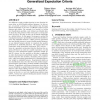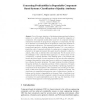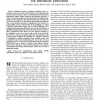404 search results - page 76 / 81 » An Approach to Classify Semi-structured Objects |
SIGIR
2008
ACM
13 years 7 months ago
2008
ACM
It is difficult to apply machine learning to new domains because often we lack labeled problem instances. In this paper, we provide a solution to this problem that leverages domai...
ICCV
2009
IEEE
13 years 5 months ago
2009
IEEE
Hybrid generative-discriminative techniques and, in particular, generative score-space classification methods have proven to be valuable approaches in tackling difficult object or...
ICSE
2004
IEEE-ACM
14 years 8 months ago
2004
IEEE-ACM
One of the main objectives of developing component-based software systems is to enable efficient building of systems through the integration of components. All component models def...
TIFS
2008
13 years 7 months ago
2008
Abstract--Statistical pattern recognition techniques have recently been shown to provide a finer balance between misdetections and false alarms than the more conventional intrusion...
PRIB
2010
Springer
13 years 6 months ago
2010
Springer
Abstract. Supervised classifiers require manually labeled training samples to classify unlabeled objects. Active Learning (AL) can be used to selectively label only “ambiguous�...



